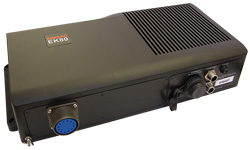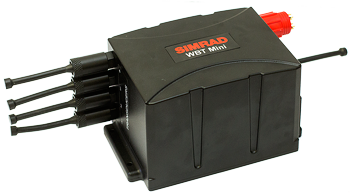Transceiver Unit description
The transceiver is provided to transmit acoustic energy through water. This transmission and reception are commonly referred to as a ping. After each transmission, the transceiver receives the echoes from the seabed and/or the seabed. These echoes are filtered, amplified and finally converted into digital format.
The EK80 software supports several different transceiver units. Several transceivers may be used simultanously.
Wide Band Transceiver (WBT)

The Wide Band Transceiver (WBT) comprises a rugged box providing all necessary transmitter and receiver electronics. The receiver is designed for low noise, and it can handle input signals spanning a very large instantaneous dynamic amplitude
range. All targets are correctly measured. The transceiver operates within a large frequency band, and supports single frequencies, frequency sweep (chirp) and user
defined wave forms.
The Wide Band Transceiver (WBT) is designed for applications where performance is the top priority. It has four 500 W channels that can either work independently with single beam transducers, or together with a split beam
transducer. The design is optimized for applications where power consumption and physical size is not critical.
A high quality Ethernet cable connects the Wide Band Transceiver (WBT) to the computer. The distance between the computer and the transceiver can be extended up to maximum 70 meters. If a longer cable is required, cut it in half, and insert an Ethernet switch to provide buffer amplification.
The Wide Band Transceiver (WBT) requires an external power supply offering 12 to 15 Vdc, minimum 5 A. A suitable power supply is provided with the delivery. The transceiver can also be powered by a large capacity battery.
Note
If more than one Wide Band Transceiver (WBT) is used, a small high capacity Ethernet switch is required to connect the transceivers
to the computer.
WBT Mini

The WBT Mini is a compact version of the highly efficient Wideband Transceiver (WBT) used by marine research vessels all around
the world. Typical deployments include portable echo sounders and any other surface platforms that may benefit from its compact size
and energy-efficient design. The WBT Mini has a small size, high capacity and low power consumption, and - as an option - autonomous operation.
The transceiver electronics in the WBT Mini have the linear FM (chirp) and CW pulse forms similar to the Wideband Transceiver. It contains four individual transceiver channels with multiplexing functionality. This allows for great flexibility when you set up a system with various split-beam or single-beam transducer configurations.
The WBT Mini is contained in a splash-proof cabinet. The robust design allows long-term deployment in challenging environments. The WBT Mini requires an external power supply.
WBT Tube
The WBT Tube is a depth rated version of the highly efficient Wide Band Transceiver (WBT) used by marine research vessels
all around the world. The WBT Tube is contained in a pressure rated tube. It is designed for long term use down to 4000 metres water depth. Typical deployments include moorings, subsea structures for environmental monitoring and probes.
The shape and pressure rating makes the WBT Tube an ideal solution for subsea structures with multiple sensors. Each WBT Tube contains two independent transceiver boards as well as a multiplexed output. This makes it possible to ping on two split-beam transducer simultaneously, or four split-beam transducers using alternate pinging on two at a time.
The transceiver electronics in the WBT Tube have the same linear FM (chirp) and CW pulse forms as the Wide Band Transceiver. It contains eight individual transceiver channels with multiplexing functionality. This allows for great flexibility when you set up a system with various split-beam or single-beam transducer configurations.
The WBT Tube requires an external power supply. Two versions are available, one for 15 VDC operation ,and one for or 24 VDC. It communicates with the computer using one high speed Ethernet line for each transceiver in use.